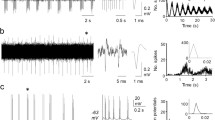Abstract
The effects of 1·10−5–1·10−3 M dopamine on background and evoked interneuronal-activity was investigated during experiments on a spinal cord segment isolated from 11–18-day old infnat rats. Dopamine induced an increase in background firing activity rate in 52.5% and a reduced rate in 42.5% of the total sample of responding cells. Dopamine exerted a primarily inhibitory effect on interneuronal activity invoked by dorsal root stimulation, as witnessed by the reduced amplitude of the postsynaptic component of field potentials in the dorsal horn together with the fact that invoked activity was depressed in 66.7% of total interneurons responding to dopamine and facilitated in only 33.3% of these cells. All dopamine-induced effects were reversible and dose-dependent. Dopamine-induced effects disappeared after superfusing the brain with a solution containing 0–0.1 mM Ca2+ and 2 mM Mn2+, suggesting that this response is of transsynaptic origin. In other cells the excitatory or inhibitory action of dopamine also persisted in a medium blocking synaptic transmission; this would indicate the possibility of dopamine exerting depolarizing and hyperpolarizing effects on the interneuron membrane directly. Contrasting responses to dopamine in interneurons may be attributed to the presence of different types of dopamine receptors in the spinal cord.
Similar content being viewed by others
Literature cited
V. N. Oksamitnyi and Z. A. Tamarova, "Inhibitory effects of dopamine on transmission of excitation in spinal cord isolated from the rat," Neirofiziologiya,18, No. 5, 616–621 (1986).
V. N. Oksamitnyi and Z. A. Tamarova, "Depolarizing effect of dopamine on motoneurons of a spinal cord segment isolated from infant rats," Neirofiziologiya,19, No. 6, 735–741 (1987).
V. N. Oksamitnyi and Z. A. Tamarova, "Depolarizing effect of dopamine on primary afferent fiber terminals of a spinal cord segment isolated from infant rats," Neirofiziologiya,19, No. 6, 741–748 (1987).
S. Barasi and K. N. Duggal, "Antinociceptive effects of dopaminergic agents in the spinal cord of the rat," Phil. Trans. R. Soc., London, Ser. B,308, No. 1136, 429 (1985).
T. J. Biscoe, D. R. Curtis, and R. W. Ryall, "An investigation of catecholamine receptors of spinal interneurons," Int. J. Neuropharmacol.,5, 429–434 (1966).
D. R. Curtis, A. W. Duggan, and G. A. Johnston, "The specificity of strychnine as a glycine antagonist in the mammalian spinal cord," Exp. Brain Res.,12, No. 5, 547–565 (1971).
P. Demenge, P. Mouchet, B. Guerin, and C. Feuerstein, "Identification and distribution of neuroleptic binding sites in the rat spinal cord," J. Neurochem.,37, No. 1, 53–59 (1981).
S. M. Fleetwood-Walker and P. J. Hope, "A selective antinociceptive effect of the diencephalic dopamine-containing cell group All on dorsal horn neurones in the rat," J. Physiol.,364, 47P (1985).
S. M. Fleetwood-Walker, P. J. Hope, and V. Molony, "Dopamine inhibits the response of multireceptive dorsal horn neurones to noxious, but not innocuous, cutaneous stimulation in the rat and cat," J. Physiol.,354, 95P (1984).
T. P. Hicks and H. McLennan, "Action of octopamine upon dorsal horn neurons of the spinal cord," Brain Res.,157, No. 3, 402–406 (1978).
T. S. Jensen, H. D. Schroder, and D. F. Smith, "The role of spinal pathways in dopamine mediated alteration in the tail-flick reflex in rats," Neuropathology,23, No. 2A, 149–153 (1984).
R. S. Hsu and B. Libet, "Hyperpolarizing responses of single mammalian sympathetic neurons to acetylcholine and to dopamine," J. Auton. Nerv. Syst.,16, No. 3, 181–191 (1986).
S. O. Kyaalp, J. S. Rubenstein, and N. H. Neff, "Inhibition of dopamine D-1 and D-2 binding sites in neuronal tissue by ascorbate," Neuropharmacology,20, No. 3, 409–410 (1981).
K. Kondo, H. Fujiwara, and C. Tanaka, "Autoradiographic evidence for dopaminergic innervation in guinea pig spinal cord," Jpn. J. Pharmacol.,38, No. 4, 442–444 (1985).
O. Lindvall, A. Björklund, and G. Skagerberg, "Dopamine-containing neurons in the spinal cord: anatomy and some functional aspects," Ann. Neurol.,14, No. 3, 255–260 (1983).
G. P. Ryan, J. C. Hackman, C. J. Wohlberg, and R. A. Davidoff, "Potential changes of frog afferent terminals in response to dopamine," Brain Res.,328, No. 2, 283–290 (1985).
O. R. Simon and L. P. Schramm, "Spinal superfusion of dopamine excites renal sympathetic nerve activity," Neuropharmacology,22, No. 2, 287–293 (1983).
Additional information
A. A. Bogomolets Institute of Physiology, Academy of Sciences of the Ukrainian SSR, Kiev. Translated from Neirofiziologiya, Vol. 21, No. 1, pp. 7–16, January–February, 1989.
Rights and permissions
About this article
Cite this article
Oksamitnyi, V.N., Tamarova, Z.A. Effects of dopamine on background and evoked activity in interneurons of a spinal cord segment isolated from infant rats. Neurophysiology 21, 5–12 (1989). https://doi.org/10.1007/BF01059095
Received:
Issue Date:
DOI: https://doi.org/10.1007/BF01059095




